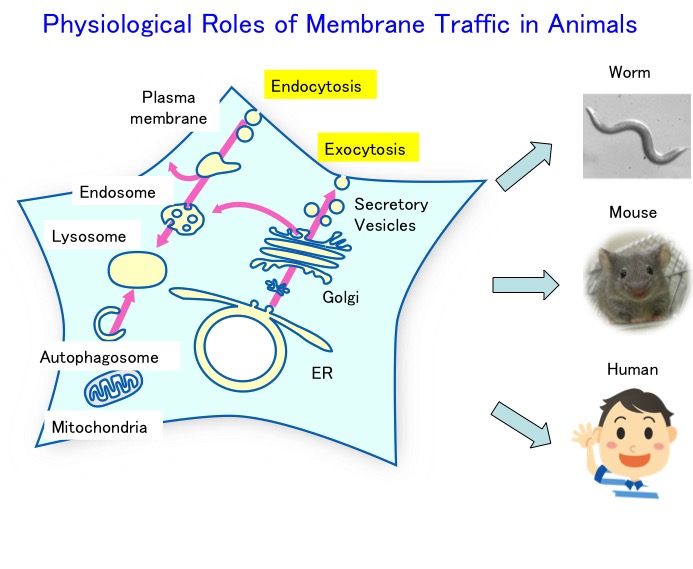Member
Professor: SATO Ken
Associate Professor: SATOUH Yuhkoh
Assistant Professor: MAEJIMA Ikuko
Technical Officer: USHIGOME Takeshi
Postdoctoral Fellow: HIRAI Rika
Postdoctoral Fellow: SUTO Shunichi
Associate Researcher: KAWASAKI Ichiro
JSPS Research Fellow: SUGIURA Kenta
Technical Assistant: AKUZAWA Tomoko
Technical Assistant: SEKIGUCHI Megumi
Technical Assistant: MIYAZAWA Noriko
Graduate Student: MICHIZAKI Mamoru
Graduate Student: AIKAWA Takashi
Graduate Student: WADA Aya
Research
Membrane trafficking plays essential roles not only in secretion and nutrient uptake but also in various physiological processes such as those involving the endocrine system, metabolic system, and nervous system in animals. In our laboratory, we study the molecular mechanisms and physiological functions of membrane trafficking in multicellular organisms by using the nematode Caenorhabditis elegans and mice as model systems. In addition, we study the molecular mechanisms underlying protein-misfolding diseases, in which abnormal membrane proteins accumulate in the endoplasmic reticulum (ER), in order to discover new targets for the treatment of such diseases.
On-going projects
- Analysis of molecular mechanisms underlying trafficking of low-density lipoprotein and insulin
- Analysis of physiological functions of membrane trafficking during development
- Analysis of physiological roles of membrane trafficking during brain development
Keywords
Membrane trafficking, Secretion, Metabolism, Development, C. elegans, Mouse, Fertilization, Autophagy, Mitochondria, Endoplasmic reticulum
Select References
- Satouh Y. et al. (2025). Elife. (2025) 3:RP99358.
- Satouh Y. et al. (2024).Biol Reprod.(2024)111(4):931-941.
- Kawasaki I., Sugiura K. et al. (2024). Nat Commun. (2024) 15(1):792
- Sasaki T. et al., (2024) Nat Commun. (2024) 15(1):1460
- Maejima I. et al. Commun Biol. (2023) 6(1):440
- Morita A. et al. (2021) Development. 148(14):dev199461
- Kunii M. et al. (2021) J Cell Biol. 220(1):e201910080
- Yamamoto YH. et al. (2020) J Cell Biol. 219(8):e201903127
- Umeda R. et al. (2020) Nat Commun. 11(1):1606
- Saegusa K. et al. (2018) J. Cell Biol. 217(6):2073-2085
- Sato M. et al. (2018) Nature Cell Bilol. 20(1):81-91
- Sakaguchi A. et al. (2015) Dev. Cell. 35(2):211-21
- Hara T. et al. (2014) Sci Rep. 4:6992
- Saegusa K. et al. (2014) Mol Biol Cell. 25(20):3095-104
- Sato M. et al. (2014) Development. 141(6):1324-31
- Sato M. and Sato K. (2011) Science. 334(6059):1141-4









